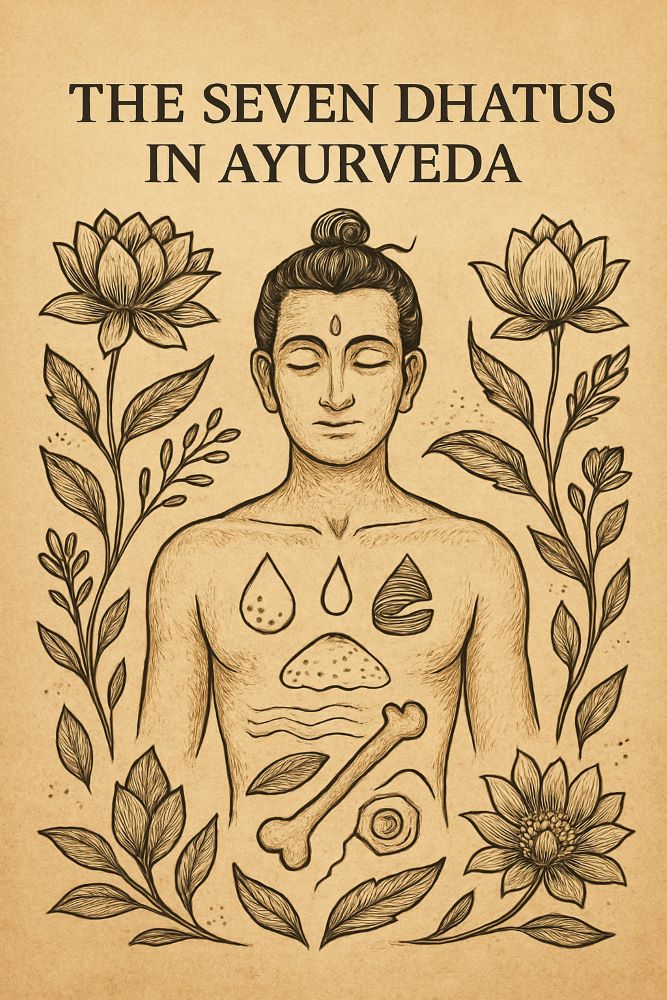
At the heart of Ayurveda lies a deep understanding of the five elements (air, earth, fire, water, and space/ether), the three gunas (characteristics of nature that include sattva/purity, rajas/motion, and tamas/inertia) and the seven dhatus (the tissues or building blocks of the body that include the plasma/lymph, blood, muscle, fat, bone, bone marrow and reproductive fluids). In this article, we will focus on the seven dhatus – the fundamental bodily tissues that sustain life, structure, and function. According to the wisdom of Ayurveda, the health of these dhatus determines our physical vitality, immunity, and longevity.
What Are Dhatus?
In Sanskrit, “Dhatu” means that which holds or supports. The dhatus are the building blocks of the body; each has specific, unique role in maintaining physiological health. According to classical Ayurvedic texts like the Charaka Samhita and Sushruta Samhita, these seven bodily tissues are sequentially formed and nourished through digestion and metabolism, starting with the food we eat, known as “ahara”, and progressing through a process of transformation that is governed by agni (the digestive/metabolic fire).
The Seven Dhatus Explained
1. Rasa Dhatu (Plasma/Lymph)
- Function: Nourishment, hydration, and transportation of nutrients.
- Modern Equivalent: Plasma, lymphatic fluids, and interstitial fluids.
- Signs of Imbalance: Dryness, fatigue, low immunity, poor digestion.
Rasa is the first of all of the dhatus. It is the initial product that comes from the digestion and metabolism of food. It is liquid in nature, and is known as the primary waters of the body. As such, it is the plasma, lymph and the interstitial fluids that nourish all tissues and is essential for a robust immune system.
2. Rakta Dhatu (Blood)
- Function: Oxygenation, vitality, and life force.
- Modern Equivalent: Red blood cells and related circulatory elements.
- Signs of Imbalance: Inflammation, skin disorders, anger, nosebleeds.
Rakta is closely linked to Pitta dosha which is derived from the elements of fire and water. Rakta energizes the body, providing its hue, exuberance and vitality. When you see a child with rosy cheeks or an adult with a beautiful, bright complexion, think of the rakta dhatu!
3. Mamsa Dhatu (Muscle Tissue)
- Function: Movement, strength, and structural support.
- Modern Equivalent: Skeletal muscles, flesh.
- Signs of Imbalance: Muscle wasting, stiffness, weakness.
“Mamsa” in Sanskrit means muscle/meat/flesh; therefore this dhatu refers to the body’s muscles which allow us to move about in our lives. Mamsa gives the body its structure and shape, stability and strength, and it confers courage, grounding, confidence, grit and stamina.
4. Meda Dhatu (Fat Tissue)
- Function: Lubrication, insulation, and energy storage.
- Modern Equivalent: Adipose tissue.
- Signs of Imbalance: Obesity, lethargy, hormonal imbalance.
The meda dhatu refers to the fatty tissues of the body including the oil on our skin. Meda supports the body’s endurance and regulates its metabolism. It provides lubrication, nourishment, and energy storage, and contributes to skin health and body temperature regulation. However, because meta dhatu is derived from the elements of water and earth, in excess it can lead to an imbalance of the Kapha dosha – leading to obesity and metabolic health.
5. Asthi Dhatu (Bone Tissue)
- Function: Structure, support, and protection.
- Modern Equivalent: Bones, cartilage, teeth.
- Signs of Imbalance: Weak bones, joint pain, hair and nail problems.
Asthi is the Sanskrit word for bones. Asthi is the bones of the body, which of course, are critical for form and stability; it houses bone marrow and supports movement, allowing us to stand up, sit down, bend down, tilt over and fold ourselves up into all kinds of shapes in our yoga practice. It also represents our hair, teeth, and nails.
6. Majja Dhatu (Bone Marrow & Nervous Tissue)
- Function: Fill bone cavities, nourish the brain and nerves.
- Modern Equivalent: Bone marrow, nervous tissue, brain.
- Signs of Imbalance: Neurological issues, confusion, tremors.
“Majja” means “pulp”, and for our purposes, it’s the pulp the fills the bones, aka bone marrow. In Ayurveda, the majja dhatu refers to both the bone marrow and the nervous system. This is because majja is closely related to the brain and spinal cord and is responsible for nervous system function, the health and lubrication of our bones, and our overall strength and well-being. Majja is rich and unctuous in nature and helps to keep VATA dosha, which is related to the bones and is made from the elements of air and space/ether, in proper balance.
7. Shukra Dhatu (Reproductive Tissue)
- Function: Reproduction, vitality, and regeneration.
- Modern Equivalent: Semen, ovum, and reproductive fluids.
- Signs of Imbalance: Infertility, low libido, hormonal issues.
In Sanskrit, shukra means bright, clear and radiant! It is the “essence” of a thing. The shukra dhatu is the seventh and the final dhatu formed by the body, following the sequential nourishment derived from the previous six dhatus. It refers to the reproductive tissues – semen in males and ovum (egg) in females. It is believed to contain the essence of all dhatus, thus representing the body’s ultimate refined energy.
The Sequential Flow of Nutrition
The dhatus are nourished in a sequential manner:
Rasa is formed first from digested food. It nourishes rakta, which in turn, nourishes mamsa, and so on. If agni, the digestive fire, becomes impaired and digestion and/or metabolism is poorly affected, this vital chain of nourishment can get disrupted, leading to disease. Therefore, maintaining a pure, strong agni is crucial for healthy tissue formation.
The Importance of the Dhatus in Ayurveda
- Diagnosis: Ayurvedic practitioners assess the state of each dhatu during diagnosis.
- Treatment: Imbalances in dhatus are treated with dietary changes, herbs, panchakarma (detoxification), and lifestyle adjustments that may include yoga and meditation.
- Prevention: By keeping the dhatus nourished and in balance, disease can be prevented and vitality enhanced.
In Conclusion
The Seven Dhatus provide a profound lens through which Ayurveda views human physiology. Their harmonious functioning is essential for health, and their imbalance is often at the root of disease. Through balanced nutrition, proper digestion, and mindful living, Ayurveda offers the tools needed to maintain the integrity of these vital tissues, leading to holistic well-being.


Leave a Reply